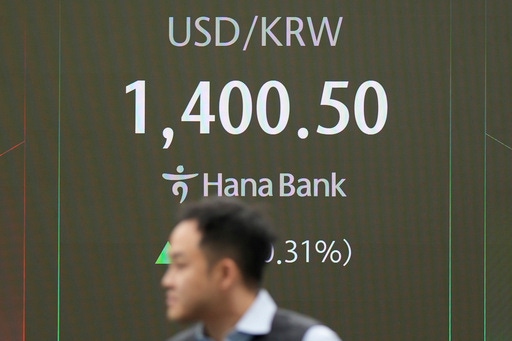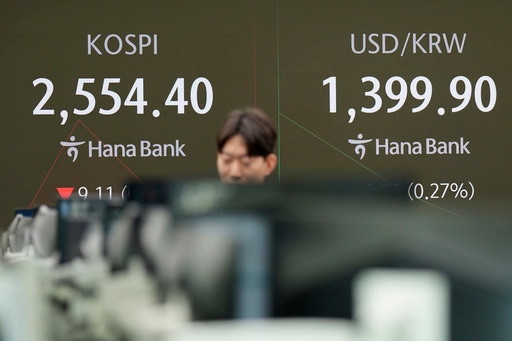Stock market today: Wall Street ticks higher after the Fed cuts interest rates, as expected

A currency trader walks by the screens showing the foreign exchange rate between U.S. dollar and South Korean won at a foreign exchange dealing room in Seoul, South Korea, Thursday, Nov. 7, 2024. (AP Photo/Lee Jin-man)[ASSOCIATED PRESS/Lee Jin-man]
NEW YORK (AP) — U.S. stocks are rising Thursday after the Federal Reserve cut interest rates for a second straight time, just as investors had expected.
The S&P 500 was up 0.6% in afternoon trading, as momentum slowed from its surge a day before following Donald Trump’s presidential victory. The Dow Jones Industrial Average was up 5 points, or 0.1%, as of 2:01 p.m. Eastern time, and the Nasdaq composite was 1.3% higher.
The Fed’s announcement that it was easing its main interest rate by the traditional-sized cut of a quarter of a percentage point caused few ripples in the market because it was so well anticipated. Attention turns next to Fed Chair Jerome Powell’s press conference, which will begin at 2:30 p.m. Eastern time.
The central bank began its rate-cutting campaign in September and pledged more to come, as it focuses more on keeping the job market humming after helping get inflation nearly down to its 2% target.
But Trump’s victory may complicate things for the Fed, and investors are waiting to hear if Powell will say whether anything will change in its plans. While lower rates help boost the economy, they can also provide fuel for inflation.
Trump is pushing for tariffs and other policies that economists say would drive inflation higher, along with the economy’s growth. Traders have already begun paring forecasts for how many cuts to interest rates the Fed will deliver next year because of that. Expectations for such cuts have been a major reason the S&P 500 has set dozens of records already this year.
On Wall Street, healthcare services company McKesson helped drive the market higher by jumping 11.6% after reporting a stronger profit for the latest quarter than analysts expected.
Lyft revved up by 22.7% after the ride-hailing app breezed past Wall Street’s sales and profit expectations, and Ralph Lauren rose 5.4% after customers in Asia and Europe helped it deliver a bigger profit than expected.
They helped make up for bank stocks, which gave back some of their stellar gains from the day before. Other “Trump trades” that had rocketed higher after the election also lost some of their juice.
JPMorgan Chase fell 3.8%, a day after banks decisively led the market on expectations that a stronger economy and lighter regulation from Washington would mean fatter profits. Smaller U.S. stocks also lagged the market, with the Russell 2000 index down 0.2%. A day before, it more than doubled the S&P 500’s gain on expectations that Trump’s America-First priorities would most benefit smaller, more domestically focused companies.
The stock that’s become most synonymous with the president-elect, Trump Media & Technology Group, fell 20.2%.
In the bond market, the yield on the 10-year Treasury eased to 4.35% from 4.44% late Wednesday. It gave back some of its surge from the prior day, driven by expectations that Trump’s plans for higher tariffs, lower tax rates and lighter regulation could lead to bigger economic growth, inflation and U.S. government debt.
A report on Thursday showed slightly more U.S. workers applied for unemployment benefits, though the number was what economists expected. A separate preliminary report said U.S. workers improved their productivity during the summer, which can help keep a lid on inflation, but not by quite as much as economists expected.
In stock markets abroad, London’s FTSE 100 fell 0.3% after the Bank of England cut its own interest rate by a quarter of a percentage point.
In Asia, Japan’s Nikkei 225 slipped 0.3% amid worries about the potential for a revival of trade tensions under a Trump administration.
“I think everybody’s going to be worried about Trump’s tariffs because that’s one of the things in his playbook. And so we’ll have to see how things develop in the early stages of his presidency this time,” said Neil Newman, head of strategy for Astris Advisory Japan.
Stocks rallied 2% in Hong Kong and 2.6% in Shanghai rallied after the Chinese government reported exports jumped in October at the fastest pace in more than two years.
Trump has promised to slap blanket 60% tariffs on all Chinese imports, raising them still more if Beijing makes a move to invade the self-governing island of Taiwan. That would add to the burdens Beijing is facing as it struggles to revive slowing growth in the world’s second-largest economy.
But the impact may be less drastic than feared, Zichun Huang of Capital Economics said in a report.
“We expect shipments to stay strong in the coming months –- any drag from potential Trump tariffs may not materialize until the second half of next year,” Huang said.
___
AP Business Writers Matt Ott and Elaine Kurtenbach contributed.
Copyright 2024 The Associated Press. All rights reserved. This material may not be published, broadcast, rewritten or redistributed without permission.
